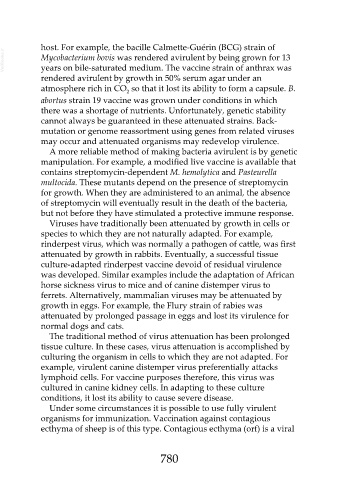Page 780 - Veterinary Immunology, 10th Edition
P. 780
host. For example, the bacille Calmette-Guérin (BCG) strain of
VetBooks.ir Mycobacterium bovis was rendered avirulent by being grown for 13
years on bile-saturated medium. The vaccine strain of anthrax was
rendered avirulent by growth in 50% serum agar under an
atmosphere rich in CO so that it lost its ability to form a capsule. B.
2
abortus strain 19 vaccine was grown under conditions in which
there was a shortage of nutrients. Unfortunately, genetic stability
cannot always be guaranteed in these attenuated strains. Back-
mutation or genome reassortment using genes from related viruses
may occur and attenuated organisms may redevelop virulence.
A more reliable method of making bacteria avirulent is by genetic
manipulation. For example, a modified live vaccine is available that
contains streptomycin-dependent M. hemolytica and Pasteurella
multocida. These mutants depend on the presence of streptomycin
for growth. When they are administered to an animal, the absence
of streptomycin will eventually result in the death of the bacteria,
but not before they have stimulated a protective immune response.
Viruses have traditionally been attenuated by growth in cells or
species to which they are not naturally adapted. For example,
rinderpest virus, which was normally a pathogen of cattle, was first
attenuated by growth in rabbits. Eventually, a successful tissue
culture-adapted rinderpest vaccine devoid of residual virulence
was developed. Similar examples include the adaptation of African
horse sickness virus to mice and of canine distemper virus to
ferrets. Alternatively, mammalian viruses may be attenuated by
growth in eggs. For example, the Flury strain of rabies was
attenuated by prolonged passage in eggs and lost its virulence for
normal dogs and cats.
The traditional method of virus attenuation has been prolonged
tissue culture. In these cases, virus attenuation is accomplished by
culturing the organism in cells to which they are not adapted. For
example, virulent canine distemper virus preferentially attacks
lymphoid cells. For vaccine purposes therefore, this virus was
cultured in canine kidney cells. In adapting to these culture
conditions, it lost its ability to cause severe disease.
Under some circumstances it is possible to use fully virulent
organisms for immunization. Vaccination against contagious
ecthyma of sheep is of this type. Contagious ecthyma (orf) is a viral
780

